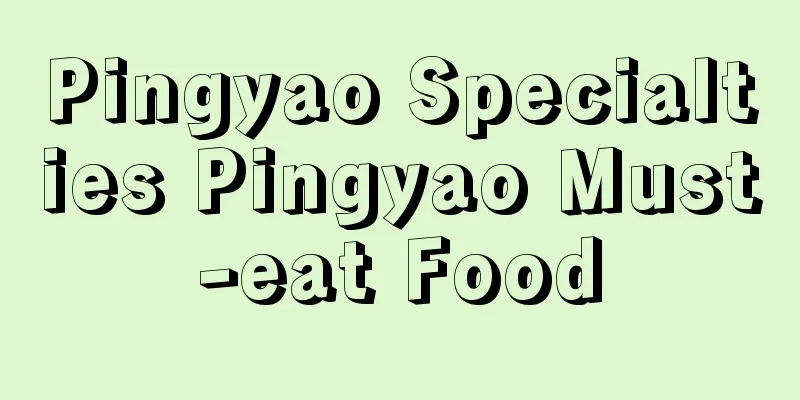Pingyao Specialties Pingyao Must-eat Food

|
When arriving at a new area, the first thing that comes to mind is what good food there is, and the second thing to do is to find places to play. It would be best if both places are together so that you can eat and play at the same time, so that you can have a great time. Today’s article introduces the must-eat snacks in Pingyao, such as Pingyao beef, bowl holders, knife-cut noodles, etc. Of course, there will also be some specialties that can be taken away. If you want to know more, you can read this article to learn more. 1. Pingyao Beef Pingyao beef is one of the essences of the profound and long-standing Chinese food culture. According to historical records, in the late Qing Dynasty, Empress Dowager Cixi passed through Pingyao and enjoyed Pingyao beef. She was so excited by its fragrance and relieved by its taste that she designated it as a tribute to the imperial palace. Pingyao beef has a unique traditional production process, from the slaughter of raw cattle, cutting of raw meat, pickling, boiling and other operating procedures and methods, to the use of salt, water and even the processing seasons, all of which are very particular. Based on the unique soil, water quality, climate, humanities and other factors, the company adopts sophisticated material selection methods and unique pickling, braising, stewing and braising techniques. The beef produced here is rosy in color, tender in texture, fat but not greasy, lean but not dry, mellow and delicious, rich in nutrients, and has the effect of strengthening the stomach and spleen. According to testing by the National Meat Food Quality Inspection Center, the calcium, iron and zinc content of Pingyao beef are 127%, 59% and 32% higher than that of ordinary beef respectively, and the vitamin content is higher than that of ordinary beef. The picture shows the Pingyao beef from Tianyuankui Hotel. The special dipping sauce makes it taste even more special. 2. Bowl holder Pingyao's bowl holder was first created by Dong Xuan, a chef from Chengnanbao during the Guangxu period of the Qing Dynasty, and has a history of more than 100 years. In the 26th year of the reign of Emperor Guangxu (1900), when Empress Dowager Cixi fled to Xi'an and passed through Pingyao, she tasted this food and praised it highly. A generous reward was given on the spot. As a result, bowl tray became famous and became a local specialty. The production method of Pingyao Wan Tou is to mix white flour with warm water into a paste, and then add a certain proportion of salt water, aniseed water and rapeseed oil. After adjusting the paste from thick to thin, pour it into a five-inch small dish and steam it in a steamer for about 15 minutes. After it is cooked through and cooled, cut it into pieces. Pingyao's bowl tray can be eaten in two ways: cold or hot. For the cold dish, cut the noodles into noodles, put them in and add vinegar, minced garlic, sesame seeds, aniseed water, chili powder, sesame oil, etc. It has a cool, fragrant, smooth and delicious feeling when eaten. To stir-fry, put cooked lard into a frying pan, add onions and garlic, then pour the strips of vegetables into the wok, add shredded yam and egg or bean sprouts, and then add seasonings such as spice water, soy sauce, and vinegar. After being fried, the aroma is overflowing, making you salivate. 3. Sliced Noodles The most famous noodle dish in Shanxi is of course knife-cut noodles. Shanxi knife-cut noodles, along with Beijing's dalu noodles, Shandong's Yifu noodles, Henan's baked fish noodles and Sichuan's dandan noodles, are known as China's five famous noodle products and are well-known both at home and abroad. The picture shows the knife-cut noodles at Tianyuankui Hotel There is another legend about knife-cut noodles: After the Mongolian Tatars invaded the Central Plains, they established the Yuan Dynasty. In order to prevent the "Han people" from rebelling, they confiscated all metal from every household and stipulated that 10 households share one kitchen knife, which they would take turns using for cutting vegetables and cooking, and then return to the Tatars for safekeeping after use. One day at noon, an old lady kneaded the dough and asked the old man to get a knife. However, the knife had been taken away by someone else, so the old man had to return. When leaving the Tatar gate, the old man's foot was hit by a piece of thin iron sheet, which he picked up and put in his arms. After returning home, the pot was boiling and the whole family was waiting for the knife to cut the noodles, but the knife was not brought back. The old man was so anxious that he turned around and around. Suddenly, he remembered the iron sheet in his arms, so he took it out and said: Use this iron sheet to cut the noodles! The old woman took a look and found that the iron sheet was thin and soft. She muttered: "How can such a soft thing cut noodles?" The old man said angrily: "If you can't cut it, just chop it." The word "chop" reminded the old woman. She put the dough on a wooden board, held it with her left hand, held the iron sheet with her right hand, stood by the boiling water pot and "chopped" the noodles. Pieces of noodles fell into the pot. After they were cooked, they were scooped into a bowl, poured with marinade and let the old man eat first. The old man ate and said: "Very good, very good, I don't need to get the kitchen knife to cut noodles in the future." In this way, word of mouth spread from one to ten, and from ten to a hundred, and it spread all over Jinzhong. Later, when Zhu Yuanzhang established the Ming Dynasty, this kind of "chopped noodles" spread among small vendors in society. After several reforms, it evolved into the current knife-cut noodles. The traditional operation method is to hold the noodles in one hand and the knife in the other hand, and then cut them directly into the pot of boiling water. The key is: "The knife does not leave the noodles, and the noodles do not leave the knife. Keep your arms straight and your hands flat. Hold your hands in a line, one edge after another. A flat knife makes flat strips, and a curved knife makes three-edged strips." If eating knife-cut noodles is a feast for the taste buds, then watching them is a feast for the eyes. The noodle-cutting masters in the catering industry can cut 118 times per minute and shave 25 kilograms of wet dough per hour, which is dazzling to watch. "One leaf falls into the pot, another leaf floats away, A leaf left his face and a knife came out. Silver fish fell into the water and turned into white waves, Willow leaves fall from the treetops in the wind. " The knife-cut noodles in many restaurants are usually made in the open, and the process itself is an artistic expression. There are many robots cutting noodles in the ancient city. The price of knife-cut noodles is generally 8-10 yuan, depending on the sauce. 4. Kaoluoluo The origin of the name "Kaoluoluo" is that its shape resembles a kind of farm tool called "Kaoluo". It is a staple food made from steamed oatmeal. A kaoluo is a round frame made of bamboo strips or willow twigs with uniform thickness at the top and bottom. It is shaped like a bucket and is a tool used by farmers to fetch water or store things. It is also called a bamboo bucket. There is also a saying among the people that it is said that when Li Shimin and his son started their army in Taiyuan, they used this kind of noodles to reward the three armies and established the Tang Dynasty in one fell swoop. The word "kuoluo" is derived from the word "reward". People have given eating oat noodles "kuoluo" beautiful symbols such as "solidity" and "harmony". In some mountainous areas, the bride and groom also eat it when they get married, which means that the couple will live together until old age. It is especially important to eat it at the end of the year to pray for family harmony and good fortune. The picture shows the beef kuoluoluo from the world-famous Tianyuankui Restaurant. There is another way to eat kuoluoluo - dry-frying. |
>>: Must-eat food in Huanglongxi Ancient Town
Recommend
How to make corn, carrot and pork bone soup
When you are married or have a significant other,...
Authentic Indian curry shrimp recipe
Food is the most important thing for people. Only...
How to cook large intestine with chestnuts
Our lives cannot be separated from friends, and g...
How to make sweet pear lotus root cake
Sweet pear lotus root cake is a common home-cooke...
How to make chocolate finger cookies
As the National Day holiday is approaching, you m...
How to make spicy crispy fish
We call people who like to eat "foodies"...
How to make crispy spareribs
A beautiful and fulfilling childhood will inevita...
How to make Chocolate Strawberry Daifuku
As people's living standards improve, they be...
How to make brown sugar apple tremella soup
Cooking is not only an essential skill in life, b...
How to make braised spareribs with taro flavor
Here is an introduction to the method of braised ...
How to make Worcestershire sauce beef balls
A beautiful and fulfilling childhood will inevita...
How to make celery omelette
Your parents have taken care of your food, clothi...
How to make black rice flour chiffon cake
In life, everyone cannot do without the word &quo...
How to make minced meat fried corn and carrot
When I get home from get off work, I should cook ...
How to make double melon juice
As a woman, should you learn to cook some decent ...









